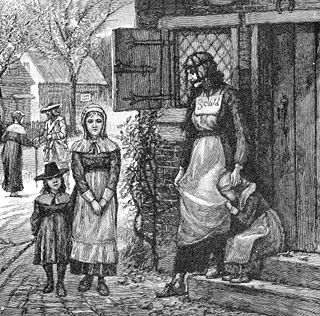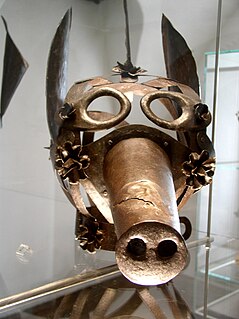
The breaking wheel or execution wheel, also known as the Catherine wheel or simply the Wheel, was a torture method used for public execution primarily in Europe from antiquity through the Middle Ages into the early modern period by breaking the bones of a criminal or bludgeoning them to death. The practice was abolished in Bavaria in 1813 and in the Electorate of Hesse in 1836: the last known execution by the "Wheel" took place in Prussia in 1841. In the Holy Roman Empire it was a "mirror punishment" for highwaymen and street thieves, and was set out in the Sachsenspiegel for murder, and arson that resulted in fatalities.

Flagellation, flogging or whipping is the act of beating the human body with special implements such as whips, rods, switches, the cat o' nine tails, the sjambok, the knout, etc. Typically, flogging is imposed on an unwilling subject as a punishment; however, it can also be submitted to willingly for sadomasochistic pleasure, or performed on oneself, in religious or sadomasochistic contexts.
Ansbach is a Landkreis (district) in Bavaria, Germany. It surrounds – but does not include – the town of Ansbach; nonetheless the administrative seat of the district is located in Ansbach. It is the district with the largest area in Bavaria.

The pillory is a device made of a wooden or metal framework erected on a post, with holes for securing the head and hands, formerly used for punishment by public humiliation and often further physical abuse. The pillory is related to the stocks.

Stocks are feet restraining devices that were used as a form of corporal punishment and public humiliation.

The iron maiden is a torture device, consisting of a solid iron cabinet with a hinged front and spike-covered interior, sufficiently tall to enclose a human being. The first stories citing the iron maiden were composed in the 19th century. The function of iron maidens closing by themselves is considered to be a myth, heightened by the belief that people of the Middle Ages were uncivilized; evidence of their actual use is difficult to find. They have become a very popular image in media involving the Middle Ages.

A scold's bridle, sometimes called a witch's bridle, a brank's bridle, or simply branks, was an instrument of punishment, as a form of torture and public humiliation. This device was overwhelmingly used on female victims and functioned to silence the victim from speaking entirely. It caused extreme pain and also physiological trauma in order to scare and intimidate the wearer into submission. It was often done so upon request from husbands or other family members. The device was an iron muzzle in an iron framework that enclosed the head. A bridle-bit, about 2 in × 1 in in size, was slid into the mouth and pressed down on top of the tongue, often with a spike on the tongue, as a compress. This prevented speaking and resulted in many unpleasant side effects for the wearer, including excessive salivation and fatigue in the mouth.
Public humiliation or public shaming is a form of punishment whose main feature is dishonoring or disgracing a person, usually an offender or a prisoner, especially in a public place. It was regularly used as a form of judicially sanctioned punishment in previous centuries, and is still practiced by different means in the modern era.

Cucking stools or ducking stools were chairs formerly used for punishment of disorderly women, scolds, and dishonest tradesmen in England, Scotland, and elsewhere. The cucking-stool was a form of wymen pine, or "women's punishment," as referred to in Langland's Piers Plowman (1378). They were instruments of public humiliation and censure both primarily for the offense of scolding or backbiting and less often for sexual offences like bearing an illegitimate child or prostitution.

Rothenburg ob der Tauber is a town in the district of Ansbach of Mittelfranken, the Franconia region of Bavaria, Germany. It is well known for its well-preserved medieval old town, a destination for tourists from around the world. It is part of the popular Romantic Road through southern Germany. Today it is one of only three towns in Germany that still have completely intact city walls, the other two being Nördlingen and Dinkelsbühl.
Amende honorable was originally a mode of punishment in France which required the offender, barefoot and stripped to his shirt, and led into a church or auditory with a torch in his hand and a rope round his neck held by the public executioner, to beg pardon on his knees of his God, his king, and his country.

A cangue or tcha is a device that was used for public humiliation and corporal punishment in East Asia and some other parts of Southeast Asia until the early years of the twentieth century. It was also occasionally used for or during torture. Because it restricted a person's movements, it was common for people wearing cangues to starve to death as they were unable to feed themselves.

A prison uniform is the unified outward appearance of detainees in a situation of imprisonment. It is typically adapted under constraint.

Altstadt is the German language word for "old town", and generally refers to the historical town or city centre within the old town or city wall, in contrast to younger suburbs outside. Neustadt, the logical opposite of Altstadt, mostly stands for a part of the "Altstadt" in modern sense, sometimes only a few years younger than the oldest part, e. g. a late medieval enlargement.

A badge of shame, also a symbol of shame, a mark of shame or a stigma, is typically a distinctive symbol required to be worn by a specific group or an individual for the purpose of public humiliation, ostracism or persecution.

A shrew's fiddle or neck violin is a variation of the yoke, pillory or rigid irons whereby the wrists are locked in front of the bound person by a hinged board or steel bar. It was originally used in the Middle Ages as a way of punishing those who were caught bickering or fighting.

Ludwig Siebert was a Nazi politician and Bavarian Minister President from 1933 to 1942.

The Franciscan Friary of Rothenburg ob der Tauber is a former friary of the Conventual Franciscans in the town of Rothenburg ob der Tauber in Bavaria in the diocese of Bamberg. Nowadays the former Franciscan church is an Evangelical Lutheran parish church.
Drowning as a method of execution is attested very early in history, for a large variety of cultures and as the method of execution for many types of offences.
The Albrechts of Rothenburg ob der Tauber were a patrician family, many of whose members occupied administrative offices in both the Interior and Exterior Councils that governed the Imperial Free City of Rothenburg ob der Tauber during the second half of the Holy Roman Empire. In addition to performing various judicial, religious and administrative roles in their home city, several Albrechts also wrote University theses that contributed, in the wider context of defining German national identity, to Law and Legal Theory during the years that spanned the Protestant Reformation, the Thirty Years War, the war’s aftermath, and the German Enlightenment.
















